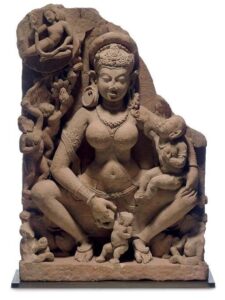
Article Written By EIH Researcher And Writer
Nayanashree Kalita
Medicine and systems of healing existed in various parts of the ancient world by the Bronze Age itself. In the Indian context, the history of health care dates back to the Indus Valley civilization and the health aspects of woman were well-thought-out since ancient times. Women’s health encompasses many different issues and in addition to all the diseases which human flesh is recipient to, she is liable gynecic diseases as well.
The Rig Veda (1500 BCE) and later Vedic Samhitas, particularly the Atharva Veda, have references to the healing and curing of ailments. There are references about the anatomy and physiology of genital organs, conception, and delivery. The Suśrutasamhitā (6th century BC) is an important Sanskrit text on medicine, considered to be one of the earliest major works related to detailed study of medicine and surgery.

Motherhood played a very significant role in ancient India, as evident from the references about maternal and child care from texts beginning from the Vedic age onwards. The Yajurveda, Brahmans (Satapatha Brahmana and Aitareya Brahmana), and the Upanisads (Garbhopanisad, Chandogyopanisad and Narayanopanisad) have all thrown light on this subject. It has been fully evaluated in Ayurveda and special branch has been devoted to the physiology and pathology of the maternity stage of a woman’s life. Numerous gestation rites (Garbha samskara) have been listed to prevent miscarriage and help protect and develop the child. Pregnant women are advised to beware of raksasas like Amiva and Durnama, also known as destroyers of Garbha, as they can cause abortion, trouble to foetus, stillbirths and neonatal deaths. Sun rays, yellow mustard and mantra incantation are suggested remedies.
Given the nature of women – they being unsteady, tender, wavering, easily disturbed and generally delicate, weak and dependant on others – medications are to be made milder for her according to ancient texts. Importance of nourishment of pregnant woman is very well identified in the Atharvaveda. Vivid descriptions of labour and instructions for safe delivery are also well documented. References to the provision of wet nurse highlight that there was a well-established system in ancient time to provide mother milk.
The number of infant death had been used as a marker of a healthy society. Abortion was a sin, but contraceptive methods were in vogue. A mechanical device made of stone, artificially induced changes to make the vaginal cavity rough or dry, herbal and herbo-mineral contraceptive preparations for local and oral use by men and women along with breathing exercises mentioned in the Brhadaranyaka Upanishad were among the earliest mention methods to prevent conception.

Although woman’s health was greatly taken care of given her significance at both social and domestic fronts, they were usually kept remote from learning medical science.




















